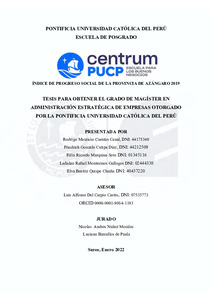| dc.contributor.advisor | Del Carpio Castro, Luis Alfonso | |
| dc.contributor.author | Cuentas Canal, Rodrigo Mauricio | |
| dc.contributor.author | Cutipa Díaz, Friedrich Gonzalo | |
| dc.contributor.author | Marquina Soto, Félix Ricardo | |
| dc.contributor.author | Montesinos Gallegos, Ladislao Rafael | |
| dc.contributor.author | Quispe Chaiña, Elva Beatriz | |
| dc.date.accessioned | 2022-08-19T17:29:06Z | |
| dc.date.available | 2022-08-19T17:29:06Z | |
| dc.date.created | 2022 | |
| dc.date.issued | 2022-08-19 | |
| dc.identifier.uri | http://hdl.handle.net/20.500.12404/23156 | |
| dc.description.abstract | La presente investigación se desarrolló con el propósito de calcular y analizar el
Índice de Progreso Social (IPS) 2019 para la provincia de Azángaro, la herramienta empleada
se estructura en tres grandes dimensiones: (a) Necesidades Humanas Básicas, (b)
Fundamentos de Bienestar, y (c) Oportunidades; este modelo permite obtener una mejor
comprensión de aspectos sociales y ambientales que definen el nivel de progreso y bienestar
social de la Provincia.
Los resultados del IPS 2019 manifestó que la provincia de Azángaro se ubica en un
nivel extremo bajo con 32.76 puntos. Se consideraron cuatro zonas de estudio: la zona 1 del
distrito de Azángaro con la mayor puntuación con 39.88 puntos, mientras, la zona 2 que
incluye los distritos de Asillo y San Antón, registró 25.03 puntos siendo el más bajo de las
cuatro; los resultados evidenciaron brechas entre las zonas, en cuanto a, la desigualdad en el
acceso de agua y saneamiento básico. Cabe destacar, que la dimensión de Necesidades
humanas básicas a pesar de alcanzar el mejor nivel de progreso social, presentó valores
críticos en los componentes de Nutrición y cuidados médicos básicos, agua y saneamiento, y
en vivienda y servicios públicos; específicamente en la tasa de desnutrición crónica en
menores de cinco años; en Agua y saneamiento básico, por la falta de acceso a los servicios
especialmente en la zona 2; y las características precarias de la vivienda, por los materiales
utilizados en su construcción.
Es necesario destacar, que los resultados de la presente investigación figuran como la
primera medición del IPS en la provincia de Azángaro; y un punto de partida a futuros
estudios, que pueden ser desarrollados a nivel distrital; además proporciona información a los
entes públicos y privados sobre la situación de la provincia. De esta forma, se recomienda
desarrollar investigaciones por cada distrito lo que permitirá contar con información detallada por sectores, manzanas, caseríos, asentamientos humanos, entre otros, donde se identifique y
analicen los elementos que provocan que la población de la provincia sea vulnerable. | es_ES |
| dc.description.abstract | This research was developed with the purpose of calculating and analyzing the Social
Progress Index (IPS) 2019 for the province of Azángaro, the tool used is structured in three
large dimensions: (a) Basic Human Needs, (b) Foundations of Well-being , and (c)
Opportunities; This model allows for a better understanding of social and environmental
aspects that define the level of progress and social well-being of the Province.
The results of the IPS 2019 showed that the province of Azángaro is located in an extremely
low level with 32.76 points. Four study areas were considered: zone 1 of the Azángaro
district with the highest score with 39.88 points, while zone 2, which includes the districts of
Asillo and San Antón, registered 25.03 points, being the lowest of the four; The results
showed gaps between the areas in terms of inequality in access to water and basic sanitation.
It should be noted that the dimension of Basic human needs, despite reaching the best level of
social progress, presented critical values in the components of Nutrition and basic medical
care, water and sanitation, and in housing and public services; specifically in the rate of
chronic malnutrition in children under five years of age; in Water and basic sanitation, due to
the lack of access to services, especially in zone 2; and the precarious characteristics of the
house, due to the materials used in its construction.
It is necessary to emphasize that the results of the present investigation appear as the first
measurement of the IPS in the province of Azángaro; and a starting point for future studies,
which can be developed at the district level; it also provides information to public and private
entities on the situation in the province. In this way, it is recommended to carry out
investigations for each district, which will allow to have detailed information by sectors,
blocks, hamlets, human settlements, among others, where the elements that cause the
population of the province to be vulnerable are identified and analyzed. | es_ES |
| dc.language.iso | spa | es_ES |
| dc.publisher | Pontificia Universidad Católica del Perú | es_ES |
| dc.rights | info:eu-repo/semantics/openAccess | es_ES |
| dc.rights.uri | http://creativecommons.org/licenses/by-nc-nd/2.5/pe/ | * |
| dc.subject | Indicadores económicos--Perú--Azángaro (Puno: Provincia) | es_ES |
| dc.subject | Indicadores sociales--Perú--Azángaro (Puno: Provincia) | es_ES |
| dc.title | Índice de progreso social de la provincia de Azángaro 2019 | es_ES |
| dc.type | info:eu-repo/semantics/masterThesis | es_ES |
| thesis.degree.name | Maestro en Administración Estratégica de Empresas | es_ES |
| thesis.degree.level | Maestría | es_ES |
| thesis.degree.grantor | Pontificia Universidad Católica del Perú. CENTRUM | es_ES |
| thesis.degree.discipline | Administración Estratégica de Empresas | es_ES |
| renati.advisor.dni | 07535773 | |
| renati.advisor.orcid | https://orcid.org/0000-0001-9084-1193 | es_ES |
| renati.author.dni | 44175340 | |
| renati.author.dni | 44212509 | |
| renati.author.dni | 01345116 | |
| renati.author.dni | 02444338 | |
| renati.author.dni | 40437220 | |
| renati.discipline | 413307 | es_ES |
| renati.juror | Nicolás Andrés Nuñez Morales | es_ES |
| renati.juror | Luciano Barcellos de Paula | es_ES |
| renati.level | https://purl.org/pe-repo/renati/level#maestro | es_ES |
| renati.type | https://purl.org/pe-repo/renati/type#tesis | es_ES |
| dc.publisher.country | PE | es_ES |
| dc.subject.ocde | https://purl.org/pe-repo/ocde/ford#5.02.04 | es_ES |






